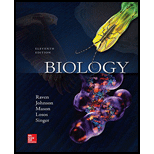
Concept explainers
Artificial selection is different from natural selection because
a. artificial selection is not capable of producing large changes.
b. artificial selection does not require
c. natural selection cannot produce new species.
d. breeders (people) choose which individuals reproduce based on desirability of traits.
Introduction:
The process by which those organisms that have favorable variations to their environment are selected in order to survive and reproduce is known as Natural selection. Artificial selection is the process in which the organisms are selected by the breeder to produce desirable traits in the offspring’s.
Answer to Problem 1U
Correct answer:
The human selects the organism that needs to reproduce on the basis of desirability of the traits through artificial selection. Therefore, option (d) is correct.
Explanation of Solution
Reason for correct statement:
Artificial selection is a man tailored mechanism that mainly occurs in the domestic population. It allows only selected traits to be inherited by the offspring. The result of the artificial selection is predetermined.
Option (d) is given as “breeders (people) choose which individuals reproduce based on desirability of traits”.
As, “in artificial selection breeder select the individual to reproduce on the basis of desired traits,” is the right answer.
Hence, option (d) is correct.
Reasons for the incorrect statements:
Option (a), is given as “artificial selection is not capable of producing large changes”.
Artificial selection tends to bring large changes. Hence, it is a wrong answer.
Option (b), is given as “artificial selection does not require genetic variation”.
The genetic variation is required for the artificial selection to occur. Hence, it is a wrong answer.
Option (c), is given as “natural selection cannot produce new species”.
The process of natural selection leads to the development of new species. Hence, it is a wrong answer.
Hence, options (a), (b), and (c), are incorrect.
The organisms that survive and reproduce are selected by the natural process. Humans select the organisms that need to reproduce with the desirable traits through the process of artificial selection.
Want to see more full solutions like this?
Chapter 21 Solutions
Biology
- Which of the following is not a DNA binding protein? 1. the lac repressor protein 2. the catabolite activated protein 3. the trp repressor protein 4. the flowering locus C protein 5. the flowering locus D protein 6. GAL4 7. all of the above are DNA binding proteinsarrow_forwardWhat symbolic and cultural behaviors are evident in the archaeological record and associated with Neandertals and anatomically modern humans in Europe beginning around 35,000 yBP (during the Upper Paleolithic)?arrow_forwardDescribe three cranial and postcranial features of Neanderthals skeletons that are likely adaptation to the cold climates of Upper Pleistocene Europe and explain how they are adaptations to a cold climate.arrow_forward
- Biology Questionarrow_forward✓ Details Draw a protein that is embedded in a membrane (a transmembrane protein), label the lipid bilayer and the protein. Identify the areas of the lipid bilayer that are hydrophobic and hydrophilic. Draw a membrane with two transporters: a proton pump transporter that uses ATP to generate a proton gradient, and a second transporter that moves glucose by secondary active transport (cartoon-like is ok). It will be important to show protons moving in the correct direction, and that the transporter that is powered by secondary active transport is logically related to the proton pump.arrow_forwarddrawing chemical structure of ATP. please draw in and label whats asked. Thank you.arrow_forward
- Outline the negative feedback loop that allows us to maintain a healthy water concentration in our blood. You may use diagram if you wisharrow_forwardGive examples of fat soluble and non-fat soluble hormonesarrow_forwardJust click view full document and register so you can see the whole document. how do i access this. following from the previous question; https://www.bartleby.com/questions-and-answers/hi-hi-with-this-unit-assessment-psy4406-tp4-report-assessment-material-case-stydu-ms-alecia-moore.-o/5e09906a-5101-4297-a8f7-49449b0bb5a7. on Google this image comes up and i have signed/ payed for the service and unable to access the full document. are you able to copy and past to this response. please see the screenshot from google page. unfortunality its not allowing me attch the image can you please show me the mathmetic calculation/ workout for the reult sectionarrow_forward
 Concepts of BiologyBiologyISBN:9781938168116Author:Samantha Fowler, Rebecca Roush, James WisePublisher:OpenStax College
Concepts of BiologyBiologyISBN:9781938168116Author:Samantha Fowler, Rebecca Roush, James WisePublisher:OpenStax College Biology (MindTap Course List)BiologyISBN:9781337392938Author:Eldra Solomon, Charles Martin, Diana W. Martin, Linda R. BergPublisher:Cengage Learning
Biology (MindTap Course List)BiologyISBN:9781337392938Author:Eldra Solomon, Charles Martin, Diana W. Martin, Linda R. BergPublisher:Cengage Learning Human Heredity: Principles and Issues (MindTap Co...BiologyISBN:9781305251052Author:Michael CummingsPublisher:Cengage Learning
Human Heredity: Principles and Issues (MindTap Co...BiologyISBN:9781305251052Author:Michael CummingsPublisher:Cengage Learning
 Human Biology (MindTap Course List)BiologyISBN:9781305112100Author:Cecie Starr, Beverly McMillanPublisher:Cengage Learning
Human Biology (MindTap Course List)BiologyISBN:9781305112100Author:Cecie Starr, Beverly McMillanPublisher:Cengage Learning Biology: The Dynamic Science (MindTap Course List)BiologyISBN:9781305389892Author:Peter J. Russell, Paul E. Hertz, Beverly McMillanPublisher:Cengage Learning
Biology: The Dynamic Science (MindTap Course List)BiologyISBN:9781305389892Author:Peter J. Russell, Paul E. Hertz, Beverly McMillanPublisher:Cengage Learning





